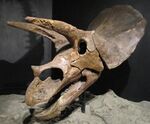Biology:Weapon
In biology, weapons are traits that are used most often by males to fight one another off for access to mates.[1] A mate is won in battle either by a male chasing off a fellow competitor or killing it off, usually leaving the victor as the only option for the female to reproduce with.[2] However, because stronger organisms, whether mentally or physically, are usually favored in combat, this also leads to the evolution of stronger organisms in species that use combat as a way to secure mates, via intrasexual selection.[3] Examples of weapons include: antlers, horns, and ossicones.
Since Darwin's publication The Descent of Man, extensive research has been done on the presence of agonistic behavior and the usage of animal weaponry by different species.[4] Weaponry displays in animals have been found to increase their likelihood of survival in different ways, such as when interacting with other individuals or trying to find another mate.[5] Weaponry in animals consist of any specialized morphology that is present within an organisms to aid in its advantage against rivals.[4] These specialized structures have different functions for animals such as competition for resources and mates, protection from predators, and much more. With the evolution of weaponry, many hypotheses have been produced by researchers to possibly explain the mechanisms behind its rapid diversification within species.[1]
Gallery
Evolution
Animal weaponry is capable of drastic and rapid diversification in form with species within the same clade having distinctly different weaponry.[1] One hypothesized mechanism for this is the gradual change in weaponry function from physical agonistic behavior to weaponry display resulting in potentially more elaborate weapons present.[1] Another possible mechanism is the presence of male-male combat, with diverging lineages of animals expanding into different habitats and then fighting under different conditions. Changes in the physical contest between species in different environments may potentially drive the evolution in modified weaponry.[1]
Competition
Agonistic behaviors amongst animals for resources have been studied by many researchers, and specifically the interaction of weapons during these exchanges of behavior.[4] Not only the presence of weaponry, but also specific characteristics of the weaponry itself can have an effect on the outcome of competition in determining the winners and losers from an intraspecies competition.[1] The display of weaponry has been found to be favored in animals that frequently engage in contest as a mechanism to decrease the costs of aggression.[1] Displays are considered any behavior that is used to show a species' fighting ability without any physical contact. This behavior allows for rivals to have the chance to assess the weaponry that is present to determine whether to engage in physical agonistic behavior or not.[4]
Selection
Darwin's idea of sexual selection has been a main focus on weaponry and antagonist interactions between animals, with males that present the largest weapons having the highest probability of winning.[6] Sexual selection has been credited by previous researchers as the main influence of nature's extravagant weaponry for the purpose of attractive females.[1] During agonistic interactions, there is the potential risk of weaponry lost resulting in a possible decrease in an individual's fighting ability and overall fitness.[6]
Female Weaponry
Since Darwin's The Descent of Man and The origin of species, research has been heavily focused on weaponry in male animals, potentially leaving out females and their possible mechanisms behind present weaponry.[7] Presence of weapons in females, and female-female competition has been seen in many species for better fitness of both sexual and social selection.[8][7] Social selection, first hypothesized by Mary Jane West-Eberhard, is a broader term that includes both sexual and non sexual behaviors to increase an individual's fitness.[7] For example, research has suggested that horns present in female bovids, may have evolved from competition for resources such as food.[8]
References
- ↑ 1.0 1.1 1.2 1.3 1.4 1.5 1.6 1.7 Emlen, Douglas J. (2008-12-01). "The Evolution of Animal Weapons" (in en). Annual Review of Ecology, Evolution, and Systematics 39 (1): 387–413. doi:10.1146/annurev.ecolsys.39.110707.173502. ISSN 1543-592X. https://www.annualreviews.org/doi/10.1146/annurev.ecolsys.39.110707.173502.
- ↑ Krebs, J. R., and Nicholas B. Davies. "Sexual Selection, Sperm Competition and Sexual Conflict." An Introduction to Behavioral Ecology. 4th ed. Oxford: Blackwell Scientific Publications, 2012.
- ↑ "Charles Darwin & Evolution." Charles Darwin & Evolution. Apr. 2014. <http://darwin200.christs.cam.ac.uk/pages/index.php?page_id=d4 >.
- ↑ 4.0 4.1 4.2 4.3 Palaoro, Alexandre V.; Peixoto, Paulo Enrique Cardoso. "The hidden links between animal weapons, fighting style, and their effect on contest success: a meta‐analysis" (in en). Biological Reviews 97 (5): 1948–1966. doi:10.1111/brv.12877. ISSN 1464-7931. https://onlinelibrary.wiley.com/doi/10.1111/brv.12877.
- ↑ Lane, Sarah M (2018-07-19). "What is a weapon?". Integrative and Comparative Biology. doi:10.1093/icb/icy083. ISSN 1540-7063. https://doi.org/10.1093/icb/icy083.
- ↑ 6.0 6.1 Emberts, Zachary; St. Mary, Colette M.; Herrington, Tyler J.; Miller, Christine W. (2018-05-03). "Males missing their sexually selected weapon have decreased fighting ability and mating success in a competitive environment" (in en). Behavioral Ecology and Sociobiology 72 (5): 81. doi:10.1007/s00265-018-2494-6. ISSN 1432-0762. https://doi.org/10.1007/s00265-018-2494-6.
- ↑ 7.0 7.1 7.2 Tobias, Joseph A.; Montgomerie, Robert; Lyon, Bruce E. (2012-08-19). "The evolution of female ornaments and weaponry: social selection, sexual selection and ecological competition". Philosophical Transactions of the Royal Society B: Biological Sciences 367 (1600): 2274–2293. doi:10.1098/rstb.2011.0280. ISSN 0962-8436. PMID 22777016. PMC 3391421. https://www.ncbi.nlm.nih.gov/pmc/articles/PMC3391421/.
- ↑ 8.0 8.1 Stankowich, Theodore; Caro, Tim (2009). "Evolution of Weaponry in Female Bovids". Proceedings: Biological Sciences 276 (1677): 4329–4334. ISSN 0962-8452. https://www.jstor.org/stable/40506066.








